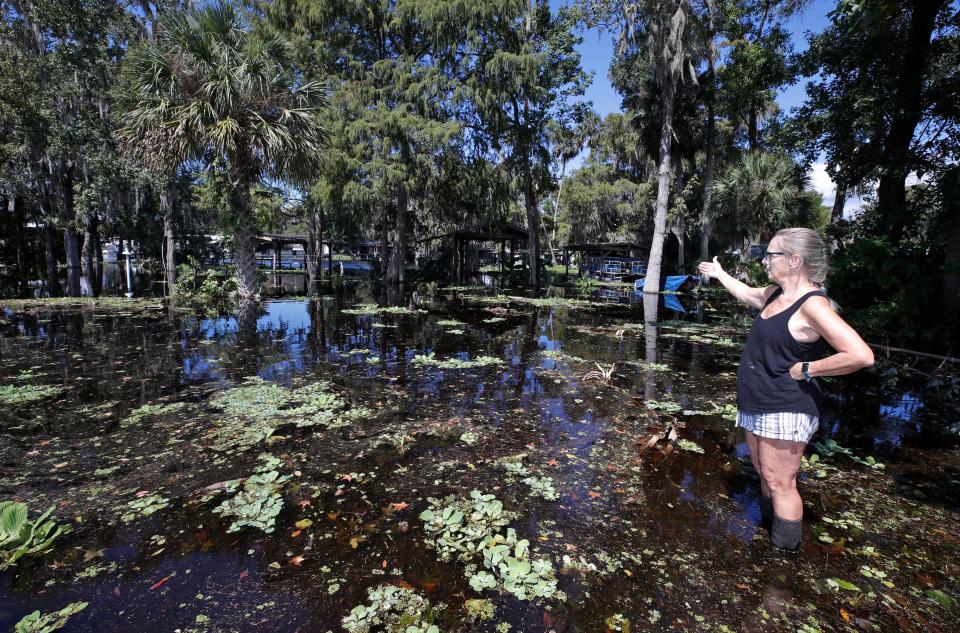Tropical Storm Ian: Astor residents face flooded streets, homes as St. Johns River rises
ASTOR — There are new, not-so-welcome neighbors in the nearly knee-deep river water that now covers the road outside of Denise Smith’s home, just north of the State Road 40 bridge on the banks of the St. Johns River in West Volusia County.
“There’s gators and everything coming up here right now, so be careful,” said Smith, who had been letting her grandson splash in the street during the sunny afternoons following Tropical Storm Ian until she realized that he might have some unwelcome company.
Get the latest on Ian's impact: As water was 'gushing in,' NSB resident escaped from home
How to apply for FEMA assistance: Find out how to apply for FEMA assistance, receive help for your business and more
Such are the hazards of daily life for Astor’s riverfront residents in the wake of the massive storm, which dumped record-shattering rainfall on the river during its slow-moving trek across Central Florida.
St. Johns River at highest level since 1933
The St. Johns River at Astor reached its crest on Saturday at 1:15 a.m. and began to recede, but the water level has fallen at such a slow pace to be nearly imperceptible.
During Ian’s assault, the river reached a record high of 4.71 feet at the U.S. Geological Survey gauge, rising almost 1.5 feet in about 48 hours. That took the river level well above the 4-foot threshold for major flood level.
The flooding broke a record set on Oct. 27, 1933, when a couple of landfalling hurricanes over the summer helped propel the high-water levels.
It also exceeded the 4.43 feet height seen after Hurricane Irma in September 2017.
For Smith and her neighbors along Nan Drive in the shadow of the Astor bridge, those statistics merely confirm what they can see by looking out their windows.
“This is the highest it’s ever been in Astor,” said Smith, 64, a longtime Floridian who survived Hurricane Andrew in South Florida and the array of others — Matthew, Irma and Dorian — that have hit Volusia County in recent years.
“This is the highest it (the river) has ever been in Astor,” she said. “In 2017, with Irma, it was pretty high, but nothing like this.”
'It doesn't feel good'
Next door, Jim Berry, a 25-year Astor resident, hunkered down helplessly during Ian as rising river waters inundated the first-floor garage apartment of his two-story house that sits at the intersection of the St. Johns and a canal leading west to more flooded homes.
Although power has been restored in the neighborhood after a 24-hour post-storm outage, Berry isn’t yet able to use his main AC unit because the compressor has four inches of water in it.
“We beat the (river level) record, but it doesn’t feel good,” said Berry, who also saw the flood waters cover and break apart a deck attached to his boat dock. “In 2017, we had no water over the seawall, but we did this time. This is the worst storm I’ve seen, for sure.”
Although the water level is receding, Berry, 59, is worried about the potential for the river to rise yet again, either as a result of rainfall or flood mitigation efforts implemented to aid drainage elsewhere along the St. Johns.
Other areas hard-hit by Ian: In Daytona's Midtown, Ian's assault continues on flooded streets, powerless homes
It’s a concern that he expressed to Lake County Emergency Management and FEMA officials that idled past his property on an assessment inspection by boat Monday afternoon.
“In 2017, there was, like, a two-week resurgence after Irma,” Berry said. “That’s what we’re worried about right now, a repeat of the flood conditions. We’ve had way more rain this time than we ever did in the past. I need the water to go down another inch for my apartment to dry.”

'I'm going to need taller boots'
Everywhere in the neighborhood, there was water where streets and green grass used to be, covering walls that once delineated a loop of canals to access the river, turning homes into a chain of islands.
“I think I’m going to need to get taller boots,” said Pam Crenshaw, 69, who offered a tour of the mini lake that now sits in the spacious backyard between her home on Bertram Road and her boat dock on one of the canals.
An Astor resident since 2005, Crenshaw has seen plenty of storms.
“I was here during Irma and this was way worse than Irma,” she said, stopping to retrieve a long wooden plank that the storm had ripped from her dock.
“There’s my board!” she said. “That’s why I probably won’t walk on the dock right now, not until you can actually see what’s happened to it.”

Even so, Crenshaw is counting her blessings.
“My house is standing; I can walk in it, and I didn’t lose my life,” she said. “I feel bad for all the people in Southwest Florida. They have so much more to deal with than whether they can walk in their yard.”
USA Today reporter Dinah Voyles Pulver contributed to this story.
This article originally appeared on The Daytona Beach News-Journal: Ian caused record flooding on St. Johns River in Astor, Florida

